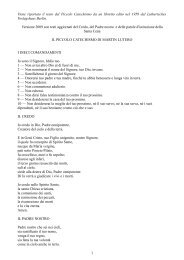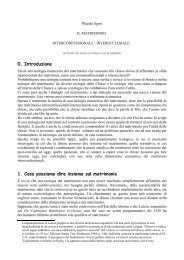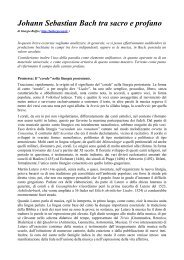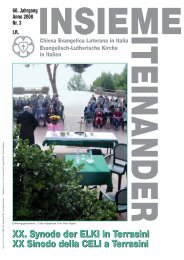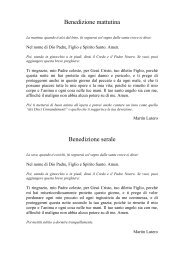Il dialogo ecumenico e interreligioso: quale futuro? - Nemesistemi
Il dialogo ecumenico e interreligioso: quale futuro? - Nemesistemi
Il dialogo ecumenico e interreligioso: quale futuro? - Nemesistemi
Create successful ePaper yourself
Turn your PDF publications into a flip-book with our unique Google optimized e-Paper software.
<strong>dialogo</strong> implica sempre più di quanto appare a prima vista, esso ha bisogno per essere un <strong>dialogo</strong><br />
fruttuoso o riuscito - di una interpretazione al di là della impostazione dei suoi autori 1 . <strong>Il</strong> dire del<br />
linguaggio vivo -però- non è quello della parola che si limita a fissare le cose nei 'nomi', come agli<br />
albori dell'umanità 2 , ma nella capacità di relazionarsi nell'alterità rivelativa fino all'inattingibile 3 ,<br />
esplorazione comune nello scambio, relazionalità che 'insiemizza' più che impone contenuti sigillati.<br />
In quel senso potrebbe anche essere riveduto il riferimento a Mtt. XVI, 16 4 . <strong>Il</strong> riconoscimento di<br />
Pietro "tu sei il Figlio di Dio" -citato spesso a metà - abbina il 'non te l'ha rivelato la carne' al 'dietro<br />
di me satana, tu non pensi secondo Dio ma secondo gli uomini' 5 . Di fatti, Pietro aveva trovato il<br />
'nome giusto'. Pietro aveva pensato che con ciò tutto si assestava col 'nome giusto' nel <strong>quale</strong> ci si<br />
può ripiegare. Gesù interpella -invece- dicendo: "occorre ascoltare oltre . Lasciate stare i<br />
preconcetti dei 'nomi' e fatevi guidare dal '<strong>dialogo</strong>' ulteriore con me... Anche la dicitura <strong>dialogo</strong><br />
potrebbe essere soltanto un nome , che avrà sempre bisogno di svelare il suo intento vitale.<br />
L INTENZIONALITÀ INTERIORE NEL DIALOGO<br />
Nel <strong>dialogo</strong> in genere si parte da una situazione di antipatia, non a livello personale ma a<br />
livello di questioni storico-dottrinali. Entrando nel vivo del cammino <strong>ecumenico</strong>, si radica nella<br />
coscienza del Popolo di Dio la consapevolezza della necessità di «essere ecumenicamente cristiani e<br />
cattolici»: dinamica che sostituisce quella previa del confronto controversiale 6 . Si passa poi ad un<br />
secondo momento di empatia 7 , cioè il comune sentimento di sofferenza per la mancata pienezza di<br />
comunione, e da questo scaturisce l apertura di mutua simpatia 8 . La via di riavvicinamento non è<br />
possibile senza una disponibilità di partenza nella simpatia aperta verso i fratelli cristiani di altre<br />
Chiese 9 .<br />
(*) On the hermeneutic aspects of the human perception of reality cf. our analysis The Relation of Man and World. Existential and<br />
Phenomenological Perspectives, in Hans Koechler, Phenomenological Realism. Selected Essays. Frankfurt a.M./Berne/New York: Peter Lang, 1986,<br />
pp. 45-58; and The Problem of Reality as Seen from the Viewpoint of Existential Phenomenology, op. cit., pp. 59-73.<br />
1 V. Hösle, Hermeneutics of Dialogue, (Erasmus Institute, Notre Dame University), in «Internet» 2004, http://www.nd.edu/~erasmus/<br />
fellows_research/past.fellows_research.2hosle_projects.html: «The reason I am particularly interested in the genre of the philosophical dialogue is<br />
that it represents a peculiar challenge to the art of interpretation, since it confronts the reader with different opinions and does not always make it clear<br />
which opinion is favoured by the author. Since furthermore, according to Gadamer, real dialogue is the model for meaningful hermeneutic activity,<br />
there is the hope that an elaboration of the different forms of interaction in philosophical dialogues may contribute to an ethics of dialogue as the basis<br />
of hermeneutics. Since Rudolf Hirzel's "der dialog" (1985) an exhaustive analysis of this literary genre is missing, even if the twentieth century is full<br />
of reflections on the ethical importance of the principle of dialogue (Mikhail Bakhtin, for example, was interested in dialogue within novels). I myself<br />
have already proposed a taxonomy of dialogues according to different criteria and discussed the question why a "correct" interpretation of a dialog<br />
must indeed go beyond its author's intentions. Now I would like to research the hermeneutics immanent in the dialogues themselves: How do<br />
understanding and misunderstanding occur in dialogues? Why do some dialogues fail? What are the ethical principles guiding the discourse? Of<br />
particular emotional importance is the dialogue, when one of its possible results is a conversion; and therefore an analysis of inter-religious dialogues<br />
promises peculiarly valuable insights into the nature of the dialogue».<br />
2 Cfr Gen., 2, 20; J. Culler, Saussure, New York 1976, pp. 22-23; H. Laborit, La cybernétique et la machine humaine, in AA. VV., Le dossier de la<br />
cybernétique, Paris 1968, p. 195.<br />
3 Cfr P. J. Labarrière, L'unité plurielle, Paris 1975, p. 98; G. Gusdorf, La parole, Paris 1977, pp. 65, 87; E. Morin, Le complexe d'Adam et l'Adam<br />
complexe, in AA. VV., Pour une anthropologie fondamentale, Paris 1974, vol. III, pp. 280-282; M. Black, The Labyrinth of Language, New York<br />
1969, p. 65; W. J. Ong, Interfaces of the Word: Television as Open System, in G. Gumpert - R. Cathcart, Inter/Media, New York 1980, p. 108; J.<br />
Charon, De la physique à l'homme, Paris 1963, p. 113; J. Vendryes, Le langage, Paris 1962, pp. 260-261; M. Jousse, L'anthropologie du geste, Paris<br />
1974, p. 151; A. Martinet, Langue et fonction, Paris 1962, pp. 188-189, 193-194; F. De Saussure, Cours de linguistique générale, Paris 1968, pp. 110-<br />
112; G. Steiner, Language and Silence, New York 1969, p. 143; C. Geffré, Le nouvel âge de la théologie, Paris 1972, p. 70; cfr E. Schillebeeckx, La<br />
crise du langage de la foi comme problème herméneutique, in «Concilium», 1973 nº 85, p. 37; V. Turner, Passages, Margins and Poverty: Religious<br />
Symbols of Communitas, in «Worship», 1972 nº 46, p. 392; J. Macquarrie, Twentieth-Century Religious Thought, London 1971, p. 317; J. Gelineau,<br />
Eléments de réflexion sur «Foi et langage», in AA. VV, Foi et langage, Paris 1977, pp. 85, 88; J. A. T. Robinson, Exploration into God, London<br />
1967, pp. 73-74)<br />
4 Paolo VI, Litterae enciclicae "Ecclesiam suam", in «Acta Apostolicae Sedis», 1964 nº 10, p. 617.<br />
5 Cfr Mtt. 16, 21-23.<br />
6 Cfr l esempio della controversia irenica: J. B. BOSSUET, Exposé de la doctrine de l'Eglise catholique sur les matières de controverse, Paris 1671;<br />
Y. Congar, Sur le jubilé de 1975, in «Unité des chrétiens», 1973 nº 12, p. 32.<br />
7 R. Panikkar, The Invisible Harmony: A Universal Theory of Religion or a Cosmic Confidence in Reality?, in L. Swildler, Toward a Universal<br />
Theology of Religion, New York 1987, p. 139.<br />
8 R. Panikkar, In Christ there is neither Hindu or Christian: Perspectives on Hindu-Christian Dialogue,<br />
9 SECRÉTARIAT POUR L'UNITÉ DES CHRÉTIENS, Réflexions et suggestions concernant le dialogue oecuménique, in «Information service»,<br />
1970 nº 2, pp. 6-7.<br />
26



